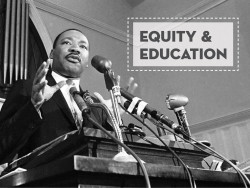
On April 16 we remember and celebrate Dr. Martin Luther King, Jr. for his call to action in the Letter from a Birmingham Jail. He warned, “Freedom is never voluntarily given by the oppressor; it must be demanded by the oppressed.” In honor of his efforts to achieve equity for African Americans, we’d like to share some resources about equity in education.
- The achievement gap lingers, especially for African American students, despite efforts by the state to increase funding and to provide additional funding for students from families with low incomes. In too many cases, that additional funding to meet the needs of adequacy and equity has been used ineffectively and not targeted to the children for whom it was intended. AACF recently completed a review of the state’s efforts to reduce the achievement gap since the settlement of the landmark Lake View settlement.
- AACF has been concerned about equity in educational facilities. New priorities for the facilities funding program threaten to worsen the disparities between poor and affluent schools. The priorities will first fund school districts with growing enrollment. These tend to be in areas with high economic growth. Districts in area with declining enrollment already lag behind in the facilities for amenities wealthier districts offer such as performing arts theatres, television broadcast facilities, and sophisticated health sciences equipment and facilities. To learn more see our video and brief here.
- Every two years as part of the adequacy study process the Bureau of Legislative Research completes an economic analysis of equity in funding. The most recent report from March 2014 uses several statistical methods to examine equity. The study concludes that “Arkansas’s equity statistics indicate a moderate decline in equity scores over the most recent three years.” The report dismisses the “high correlation” between local wealth and district revenue because it concludes other federal and state funding offset that advantage. See the whole report here.
